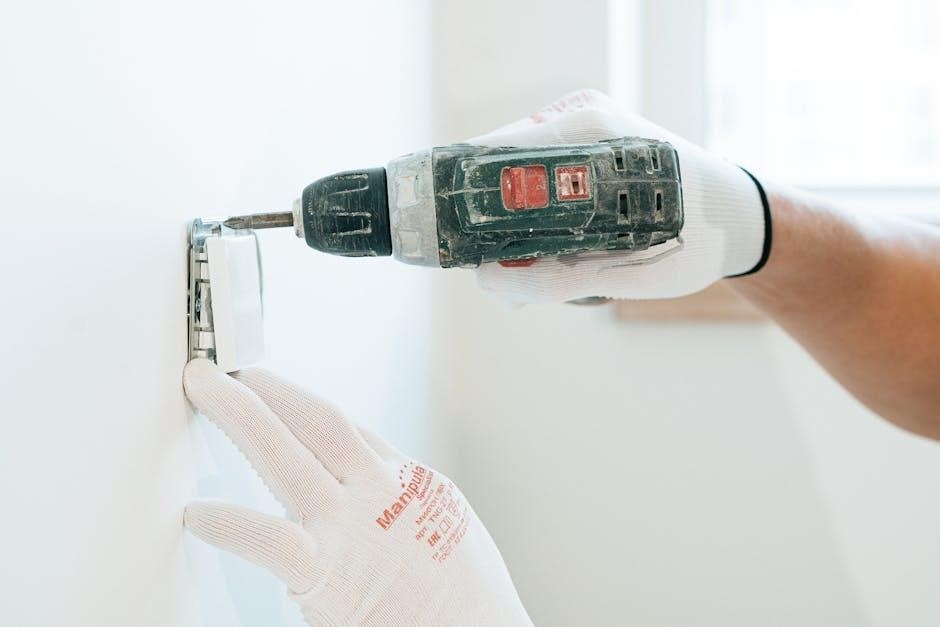biofinity multifocal toric fitting guide

Biofinity Multifocal Toric Lenses are designed for individuals with astigmatism, offering superior comfort and clarity. These lenses cater to patients needing correction for near, far, and intermediate vision.
1.1 What Are Biofinity Multifocal Toric Lenses?
Biofinity Multifocal Toric Lenses are advanced contact lenses designed to address both astigmatism and presbyopia. Combining multifocal and toric technologies, these lenses provide clear vision at near, intermediate, and far distances. The multifocal design allows for a smooth transition between different focal points, while the toric component corrects astigmatism by addressing the irregular shape of the cornea. Made with Aquaform Technology, these lenses offer high breathability and moisture retention, ensuring comfort throughout the day. They are available in a wide range of prescriptions, making them suitable for patients with diverse vision needs. Biofinity Multifocal Toric Lenses are an excellent choice for individuals seeking sharp, stable vision with minimal lens awareness.

1.2 Who Can Benefit from Biofinity Multifocal Toric Lenses?

Biofinity Multifocal Toric Lenses are ideal for individuals with astigmatism and presbyopia, offering crisp vision at near, intermediate, and far distances; These lenses cater to patients who require multifocal correction but also have astigmatism, making them a versatile solution. They are particularly beneficial for individuals who lead active lifestyles, as they provide stable vision and comfort throughout the day. The unique design addresses the challenges of astigmatism while delivering the convenience of multifocal vision correction. Patients with high astigmatism or those dissatisfied with monovision or single-vision lenses often find these lenses to be a superior alternative. With over 200,000 unique prescriptions available, Biofinity Multifocal Toric Lenses are tailored to meet diverse vision needs.

Key Considerations for Fitting
Key considerations include evaluating the patient’s prescription, ensuring proper lens fit, managing realistic expectations, and assessing patient lifestyle and ocular history for optimal results and comfort.
2.1 Understanding the Patient’s Prescription
Understanding the patient’s prescription is critical for successful fitting of Biofinity Multifocal Toric lenses. The prescription includes spherical, cylindrical, and axis measurements, which are essential for addressing astigmatism and presbyopia. The spherical power corrects nearsightedness or farsightedness, while the cylindrical power and axis specify the astigmatism correction. Accurate interpretation ensures proper alignment of the toric design with the patient’s corneal orientation. Additionally, the add power for near vision must be carefully considered to meet the patient’s specific needs. Misinterpretation of these values can lead to poor vision or discomfort. Therefore, precise evaluation of the prescription is the foundation for a successful fitting process.
2.2 Ensuring Proper Lens Fit

Ensuring a proper fit is crucial for optimal vision and comfort with Biofinity Multifocal Toric lenses. The base curve must align with the patient’s corneal shape to prevent discomfort or improper orientation. Assessing lens movement during blinking helps confirm adequate fit, while fluorescein staining can reveal irregularities. Proper orientation of the toric design ensures astigmatism correction accuracy. Improper fit may cause blurry vision or discomfort, emphasizing the need for precise evaluation. Regular follow-ups are essential to monitor lens performance and patient adaptation, ensuring long-term satisfaction and eye health.
2.3 Managing Patient Expectations
Managing patient expectations is vital for a successful fitting experience with Biofinity Multifocal Toric lenses. Clear communication about the potential benefits and limitations of these lenses helps set realistic goals. Patients should understand that multifocal lenses may require an adaptation period and that near vision clarity can vary depending on lighting conditions. Discussing their lifestyle and visual priorities ensures the lenses align with their needs. Emphasize that toric lenses are designed to correct astigmatism while providing multifocal benefits. Setting clear expectations about the fitting process, including possible follow-up adjustments, fosters trust and satisfaction. Open dialogue ensures patients are prepared for the transition to multifocal toric correction.
2.4 Patient History and Lifestyle
A thorough review of the patient’s medical history and lifestyle is essential before fitting Biofinity Multifocal Toric lenses. Assessing prior eye conditions, such as keratoconus or dry eye syndrome, helps determine suitability. Discussing their occupation, hobbies, and daily activities provides insights into their visual demands. For example, patients with active lifestyles or those requiring clear intermediate vision may benefit most. Additionally, understanding their history with contact lenses, including any previous discomfort or dissatisfaction, aids in setting realistic expectations. Evaluating tear quality and corneal health ensures proper lens fit and comfort. This comprehensive approach ensures Biofinity Multifocal Toric lenses align with the patient’s unique needs and lifestyle requirements for optimal performance.
![]()
The Fitting Process
Evaluate binocular visual acuity, then monocular, ensuring clarity. Perform over-refraction with trial lenses to refine prescription. Assess toric orientation and near/intermediate vision for optimal customization.
3.1 Evaluating Binocular Visual Acuity
Evaluating binocular visual acuity is crucial to determine how well both eyes work together. This step involves assessing the patient’s ability to see clearly at distance and near. Using standardized charts, the practitioner measures visual sharpness with both eyes open to simulate real-world vision. Proper lighting and positioning are essential for accurate results. This assessment helps identify any imbalances between the eyes and ensures the multifocal toric lenses are aligned correctly for optimal vision correction. The findings guide lens selection and adjustments, ensuring the patient achieves the best possible visual outcome with their Biofinity Multifocal Toric lenses.
3.2 Checking Monocular Visual Acuity
Checking monocular visual acuity involves assessing each eye individually to identify any differences in vision between them. This step is essential for ensuring proper lens fit and prescription balancing. The practitioner uses an eye chart to measure the sharpness of vision for each eye separately, with the other eye covered. This helps determine if one eye relies more on the multifocal or toric aspect of the lens. The results are used to fine-tune the prescription and ensure the lenses are tailored to the specific needs of each eye. Accurate monocular assessment is critical for achieving optimal vision correction and comfort with Biofinity Multifocal Toric lenses.
3.3 Performing Over-Refraction with Trial Lenses
Over-refraction with trial lenses is a critical step in ensuring the correct prescription and lens fit for Biofinity Multifocal Toric lenses. This process involves placing trial lenses on the patient’s eyes to assess how well they correct vision at different distances. The practitioner adjusts the lenses to balance vision between the eyes, ensuring clarity and comfort. Over-refraction helps fine-tune the prescription, particularly for astigmatism and presbyopia, by evaluating how the lenses perform in real-world conditions. The results guide final adjustments, ensuring the lenses meet the patient’s specific needs for near, intermediate, and far vision. This step is vital for achieving optimal visual outcomes and patient satisfaction.

3.4 Interpreting Over-Refraction Results
Interpreting over-refraction results is essential to finalize the prescription for Biofinity Multifocal Toric lenses. This step involves analyzing how the trial lenses perform in correcting near, intermediate, and far vision. The practitioner assesses visual clarity, balance between the eyes, and the patient’s comfort. If vision is blurry or uneven, adjustments to the prescription or lens parameters may be necessary. The goal is to ensure that the lenses provide sharp, clear vision across all distances while maintaining comfort. Accurate interpretation of these results is crucial for achieving optimal visual outcomes and patient satisfaction with the Biofinity Multifocal Toric lenses;
3.5 Assessing Toric Orientation
Assessing toric orientation ensures the lens is correctly aligned with the patient’s eye to optimize vision clarity. Begin by placing the trial lens on the worse eye (higher dioptric power) and evaluate its orientation. Use a pen light or slit lamp to observe the lens’s positioning and rotation. Proper alignment is crucial; misalignment can lead to blurred vision. If the lens rotates excessively, it may indicate a need for a different axis or base curve. Adjustments should be made to ensure the lens stabilizes correctly, providing clear vision at all distances. Accurate toric orientation is vital for achieving the desired visual acuity with Biofinity Multifocal Toric lenses.
3.6 Evaluating Near and Intermediate Vision
Evaluating near and intermediate vision is crucial to ensure Biofinity Multifocal Toric lenses meet the patient’s needs. Begin by assessing near vision using a reading chart or a standardized near point test. Ensure the patient can comfortably read small text without strain. Next, evaluate intermediate vision by having the patient focus on objects or tasks at arm’s length, such as computer screens. Check for clarity and minimal compromise between near, intermediate, and distance vision. Environmental factors, like lighting, can influence results, so consider these during assessment. Clear communication with the patient about their visual experience is key to achieving optimal lens performance.
3.7 Final Adjustments
Final adjustments are made to optimize lens performance and patient satisfaction. After evaluating near, intermediate, and distance vision, fine-tune the prescription if necessary. Ensure proper toric orientation and verify that the lenses rotate correctly. Check for any residual astigmatism and adjust the axis or power accordingly. Patient feedback is critical; ask about comfort and clarity at all distances. Make incremental changes and reassess until optimal results are achieved. If adaptation issues arise, consider additional follow-up or alternative solutions. Clear communication ensures the patient understands the fit and any necessary next steps. Final adjustments are the last step before confirming the prescription, ensuring the best possible outcome for the wearer.

Follow-Up Care
Follow-up care ensures optimal lens performance and patient satisfaction. Regular check-ups assess lens orientation, vision clarity, and comfort, while addressing any adaptation issues or concerns.

4.1 Assessing Lens Orientation
Assessing lens orientation is crucial for ensuring proper fit and optimal vision. Toric lenses have specific markings to help practitioners verify alignment with the eye’s astigmatism axis. During follow-up, observe if the lens rotates correctly and maintains stability. Any misalignment can cause blurry vision or discomfort. Use trial lenses or automated tools to check orientation accuracy. Ensure the lens moves slightly with eye movements, indicating a proper fit. If orientation is incorrect, adjustments may be needed. Regular assessments during follow-up appointments help maintain clear vision and comfort, ensuring the lens continues to meet the patient’s needs effectively over time.
4.2 Checking Vision at Follow-Up
During follow-up appointments, it is essential to evaluate the patient’s vision to ensure the Biofinity Multifocal Toric Lenses are performing optimally. Begin by assessing binocular and monocular visual acuity to confirm clarity and sharpness. Test near and intermediate vision to address any adaptation issues. Use trial lenses to refine the prescription if needed. Additionally, evaluate how the lenses perform in various lighting conditions to ensure consistent vision; Patient feedback is crucial; inquire about any difficulties with near, far, or intermediate vision. If vision is satisfactory, proceed; if not, consider adjustments or alternative solutions to enhance visual outcomes and patient satisfaction.
4.3 Evaluating Lens Comfort
Evaluating lens comfort during follow-up is crucial to ensure patient satisfaction and proper adaptation. Begin by asking the patient to rate their comfort level using a standardized scale. Check for signs of dryness, irritation, or redness, which may indicate poor fit or material incompatibility. Assess whether the lenses remain moist throughout the day, as Biofinity’s breathable material is designed to maintain hydration. Ensure the lenses move appropriately with each blink, as excessive movement can cause discomfort. If issues arise, consider recommending lubricating drops or adjusting the lens fit. Patient feedback is invaluable; address any concerns promptly to optimize comfort and wearer experience.
4.4 Scheduling Follow-Up Appointments
Scheduling follow-up appointments is essential to monitor the patient’s adaptation to Biofinity Multifocal Toric Lenses. Typically, the first follow-up is recommended within 1-2 weeks after the initial fitting to assess lens performance and comfort. Subsequent appointments may be spaced further apart, depending on the patient’s needs. During these visits, ensure the lenses are functioning as intended and address any concerns. Use this opportunity to reinforce proper care and hygiene practices; Consistent follow-ups help identify and resolve issues early, ensuring optimal vision and comfort. Regular check-ins also allow for adjustments in the fitting or prescription if necessary, promoting long-term satisfaction with the lenses.

Troubleshooting Common Issues
Biofinity Multifocal Toric Lenses may present issues like blurry vision, discomfort, or improper rotation. Addressing these promptly ensures optimal performance and patient satisfaction.
5.1 Addressing Blurry Vision
Blurry vision with Biofinity Multifocal Toric Lenses can stem from improper lens orientation, incorrect prescription, or poor fit. Begin by verifying toric lens alignment and ensuring proper centration. Perform an over-refraction to confirm the prescription accuracy. If issues persist, check for residual astigmatism and adjust the cylinder power or axis accordingly. Ensure the base curve matches the patient’s cornea for optimal comfort and clarity. Consulting the fitting guide and adjusting trial lenses can help resolve visual distortions, providing sharper focus at all distances. Addressing these factors promptly enhances patient satisfaction and visual acuity.
5.2 Resolving Discomfort
Discomfort with Biofinity Multifocal Toric Lenses can arise from improper fit, lens dehydration, or surface deposits. Assess lens centration and movement to ensure proper fit. Verify toric orientation to avoid induced astigmatism. Check the patient’s tear quality and recommend artificial tears if necessary. Ensure proper cleaning and maintenance routines are followed to prevent buildup. If discomfort persists, consider reassessing the base curve or material compatibility. Patient feedback is crucial; adjust the lens prescription or recommend a different product if needed. Follow-up appointments are essential to monitor comfort and address any ongoing issues promptly, ensuring optimal wearer satisfaction and lens performance.
5.3 Correcting Improper Lens Rotation
Improper lens rotation in Biofinity Multifocal Toric Lenses can cause blurred vision or eye strain. To correct this, assess the toric marks on the lens and compare them to the patient’s corneal astigmatism axis. Ensure the lens is properly aligned with the eye’s natural orientation. Use trial lenses to verify the correct rotational position and adjust as needed. If the lens consistently rotates, consider re-evaluating the base curve or fitting a different lens design. Educate the patient on proper insertion and removal techniques to minimize rotation. Follow up to confirm the lens maintains its correct orientation and the patient’s vision remains clear and comfortable.
5.4 Addressing Adaptation Issues
Adaptation to Biofinity Multifocal Toric Lenses may vary among patients. Some individuals experience initial blurry vision or eye strain due to the multifocal design. To address this, ensure proper lens fit and orientation during the fitting process. Gradually increasing wear time can help patients adapt to the lenses. Educate patients on the differences between multifocal and single-vision lenses to manage expectations. If adaptation issues persist, consider re-evaluating the prescription or exploring alternative lens options. Regular follow-ups are crucial to monitor comfort and vision clarity. Open communication with the patient ensures any concerns are promptly addressed, fostering a smooth transition to multifocal toric wear.
Biofinity Multifocal Toric Lenses offer a comprehensive solution for astigmatism, providing clear vision at all distances. Proper fitting ensures comfort and optimal performance, benefiting both practitioners and patients.
6.1 Summary of the Fitting Guide
The Biofinity Multifocal Toric fitting guide emphasizes a systematic approach to ensure optimal lens performance. Key steps include evaluating binocular and monocular visual acuity, performing over-refraction, and assessing toric orientation. Proper lens fit, patient expectations, and lifestyle considerations are crucial for success. Follow-up care involves checking vision, comfort, and lens orientation to ensure long-term satisfaction. By balancing advanced lens technology with personalized care, practitioners can deliver clear, comfortable vision for patients with astigmatism and presbyopia. This guide provides a comprehensive roadmap for fitting Biofinity Multifocal Toric lenses effectively, addressing both near and intermediate vision needs while maintaining patient comfort and visual clarity.
6.2 Final Tips for Optimal Fit
For an optimal fit with Biofinity Multifocal Toric lenses, prioritize proper toric orientation and lens centration. Ensure the patient understands the adaptation period and expectations. Schedule follow-ups to monitor comfort and vision clarity. Use trial lenses to refine the prescription and address any visual or comfort concerns early. Emphasize proper hygiene and care routines to maintain lens health. Consider the patient’s lifestyle and visual demands when fine-tuning the fit. Regularly assess lens orientation and rotation during follow-ups to ensure consistent performance. By combining these strategies, practitioners can maximize patient satisfaction and achieve the best possible outcomes with Biofinity Multifocal Toric lenses.